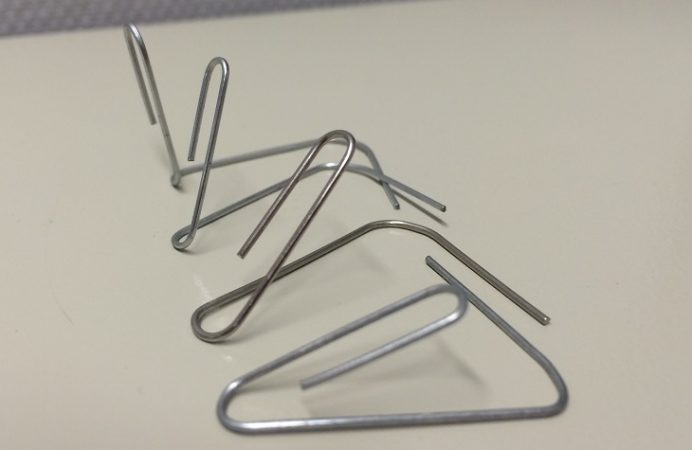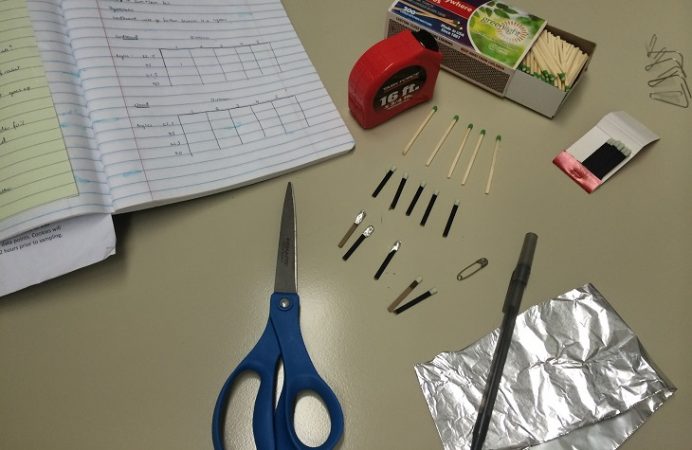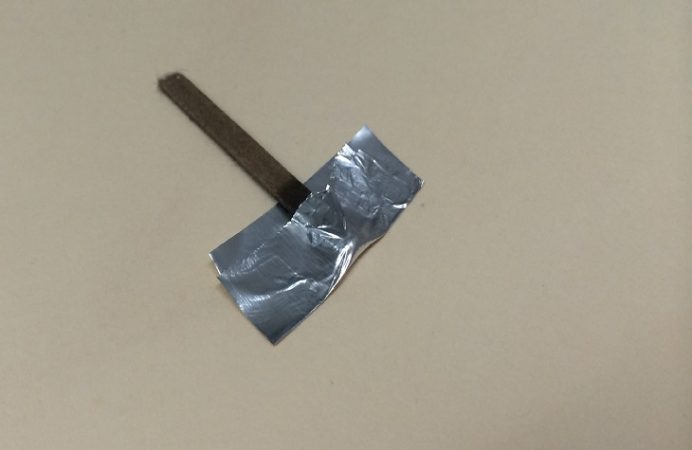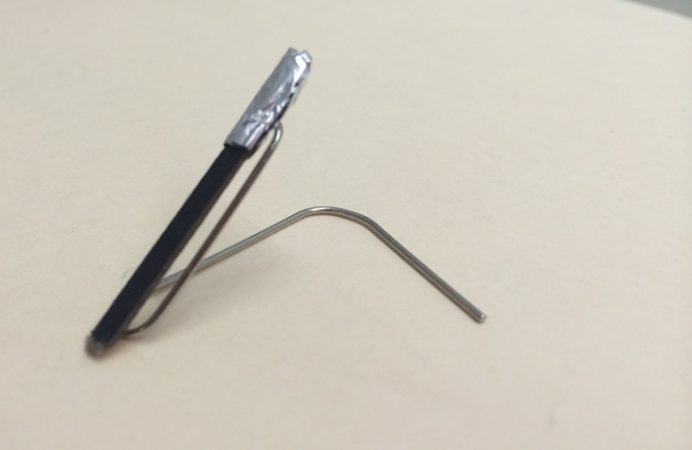A matchstick rocket may fail to launch
An experiment to test Newton’s third law produces unimpressive results

It seemed like a great idea to make tiny rockets out of matches and foil. Unfortunately, this project burned out on the launchpad.
B. Brookshire/SSP
This article is one of a series of Experiments meant to teach students about how science is done, from generating a hypothesis to designing an experiment to analyzing the results with statistics. You can repeat the steps here and compare your results — or use this as inspiration to design your own experiment.
Everyone loves exciting science demonstrations. And at first glance, making a tiny rocket out of a cardboard match seems a great prospect. Videos show these small rockets flying several feet, and making tiny explosive noises. This experiment looked so fun, I decided I had to try it for myself. And I found out that getting your match to achieve liftoff is not as simple as it appears.
The matchstick rocket is supposed to demonstrate Newton’s third law of motion — that for every action there is an equal and opposite reaction. In the case of a rocket, the action is an explosive force aimed down toward the ground, resulting in the reaction that should fling the rocket high into the air.
Newton’s law should work, regardless of a rocket’s size. So it should be possible to rocket a burning cardboard match into the air with nothing more than a safety pin, a paper clip and aluminum foil.
Scraping a “strike anywhere” match on a surface produces a flame. This happens as the highly reactive phosphorus in the match head burns. You also will get combustion — burning — when you light a match with another match. The phosphorus in the match head is so reactive that it will spontaneously burst into flame when it gets hot enough.
The idea behind a match rocket is to cage the combustion gases in a tight aluminum pocket. The only way for the gases to escape is through a small hole pointing down. Aiming that explosive force downward should propel the rocket up.
Making the rocket is simple. Take a cardboard match and a small amount of aluminum foil. I used a rectangle of foil that was about 1 centimeter by 2 centimeters (or about 0.34 inch by 0.78 inch). I carefully folded the foil around the top of the match head. I made sure to cover the whole head tightly. There were no holes in the foil. I sealed the bottom of my match’s foil covering tightly against the body of the match.
Then I opened up a safety pin. These come in various sizes, but I used the safety pin size 1, which is about 2.7 centimeters (or 1 inch) long. I carefully slid the pointed end of the pin up under my match seal. This creates the exit tube through which combustion gases can escape. I pressed the foil down carefully on both side of the pin to make sure the tube was sealed off and had no other along the side of my match.
I used a paper clip as my launchpad. I angled the inside portion of the clip upward at a 45 degree angle, and pulled out the clip’s bottom to anchor it easily on the ground.
I took my rocket and launcher outside to a cleared concrete area. I wore heavy gloves and eye protection to prevent any injury if a match went off in the wrong direction. Finally, I had someone standing by with a bucket of water, just in case. For most people, a cup of water would probably work just as well.
I used some study tape to make sure my paper clip was firmly stuck to the ground. I positioned my rocket carefully on the launchpad, leaning it up against the angled portion of the paper clip. To launch, I lit a wooden match and held it directly underneath the foil-covered head of my rocket.
In theory, the heat from the match underneath the rocket should have caused the match inside the foil to burst into flame. Since the exhaust from that reaction is tightly contained by the foil, it should have only one place to go: down the tube I had made with the safety pin. And that should have launched my rocket forward several feet with a tiny “fwish” sound.
What really happened? I wanted to test a lot of rockets, to find out how far most of them flew. So I made more than 20 cardboard match rockets. I also made 20 wooden match rockets. I planned to run an experiment to see which launchpad angle produced the longest rocket flight, and which flew farther — the cardboard or wooden rockets .
But 40 ignitions later, I had a grand total of two flights. This experiment failed to launch.
Many things went awry. The slightest breeze blew out the wooden matches I was using to ignite my rocket. I often had to light four or more to heat the foil encased match. Several times, the rocket itself caught fire, and sat burning on the launchpad. And in many cases, the rockets launched backward, slapping small bits of hot material into my hand.
Most websites instructing you on how to perform this project warn you to wear eye protection. None advise gloves. I was very grateful I had worn heavy-duty work gloves when those flaming matches started flying.
The two successful launches were a lot of fun. One even flew a thrilling 168 centimeters (or about 5.5 feet).
But overall, it was a pathetic demonstration of Newton’s third law. Perhaps my foil seal was not tight enough. Or maybe my safety pin poked holes in the foil. If you’re interested in showing off actions and reactions, you might want to try something more dependable.
If you’d like to try this at home, make sure to do it outside on a fire-resistant surface such as a driveway or sidewalk. Keep a fire extinguisher or bucket of water around to put out any small fires that might occur. Don’t forget to wear eye protection and gloves. And be prepared to light a lot of matches.
Follow Eureka! Lab on Twitter









Power Words
combust To consume by fire. Combustion is the process of burning.
phosphorus A highly reactive, nonmetallic element occurring naturally in phosphates. Its scientific symbol is P.
Newton’s laws(of motion) Three physical laws that together laid the foundation for classical mechanics. They describe the relationship between a body and the forces acting upon it, and a body’s motion in response to those forces.
rocket Something propelled into the air or through space, usually by the release of exhaust gases as some fuel burns. Or something that flings into space at high speed as if fueled by combustion.